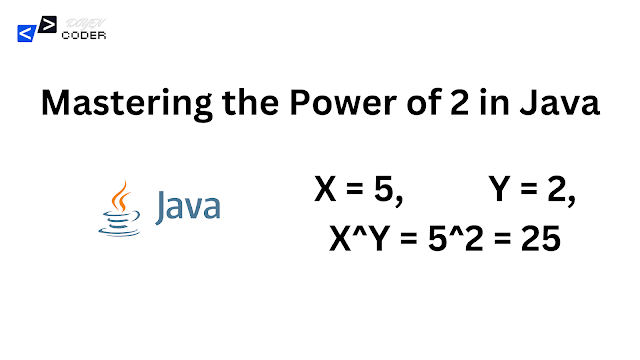Mastering the Power of 2 in Java
1. Introduction
The concept of powers of 2 is fundamental in computer science and programming. It is widely used in areas such as memory allocation, bit manipulation, and algorithm optimization. Understanding how to work with powers of 2 in Java can help you solve complex problems efficiently.
2. What is a Power of 2?
A power of 2 is a number of the form \(2^n\), where n is an integer. Examples include 1, 2, 4, 8, 16, 32, and so on. In binary, powers of 2 are represented as a single '1' bit followed by n zeros (e.g., 2 = 10, 4 = 100, 8 = 1000).
3. Checking if a Number is a Power of 2
A common problem is checking if a given number is a power of 2. This can be efficiently done using bit manipulation. If a number is a power of 2, it has only one bit set to 1 in its binary representation.
The bitwise expression `(n & (n - 1)) == 0` can be used to check if a number `n` is a power of 2. If the result is 0 and `n` is greater than 0, then `n` is a power of 2.
public class PowerOfTwoChecker { return n > 0 && (n & (n - 1)) == 0; }
public static void main(String[] args) { int number = 16; System.out.println(number + " is power of 2: " + isPowerOfTwo(number)); }}
4. Efficient Multiplication and Division by Powers of 2
Multiplying or dividing by powers of 2 is highly efficient in Java. Instead of using the multiplication (`*`) or division (`/`) operators, you can use bit-shifting, which is much faster at the CPU level.
- To multiply a number by \(2^n\), use a left shift (`<<`) by `n` positions. - To divide a number by \(2^n\), use a right shift (`>>`) by `n` positions.
public class PowerOfTwoShift { int number = 4;
// Multiply by 2 (2^1) using left shift int multiply = number << 1; System.out.println("Multiply by 2: " + multiply); // Outputs 8
// Divide by 2 (2^1) using right shift int divide = number >> 1; System.out.println("Divide by 2: " + divide); // Outputs 2 }}
5. Using Powers of 2 in Data Structures
Powers of 2 are often used in data structures like arrays, hash maps, and memory allocation. Many times, array sizes and buffer capacities are rounded to the nearest power of 2 for optimal performance. In hash maps, the number of buckets is typically a power of 2, ensuring fast modulus calculations with bitwise operations.
import java.util.HashMap;public class HashMapExample { public static void main(String[] args) { HashMap map = new HashMap<>(16); // 16 is a power of 2 map.put(1, "One"); map.put(2, "Two"); System.out.println(map); }}
6. Common Use Cases
Powers of 2 are commonly used in the following areas:
- Memory allocation and management
- Bit manipulation tasks in cryptography and compression algorithms
- Optimizing arithmetic operations
- Efficiently working with arrays and hash tables
7. Conclusion
Mastering the concept of powers of 2 and bitwise operations in Java will greatly enhance your ability to optimize performance, especially in low-level algorithms and data structures. By understanding how to check for powers of 2, efficiently multiply and divide by powers of 2, and leverage them in data structures, you can write faster and more efficient Java applications.
Summary of Content:
- Introduction: Provides a high-level overview of what powers of 2 are and their significance in Java.
- Checking if a Number is a Power of 2: Uses bitwise operations to efficiently determine if a number is a power of 2.
- Efficient Multiplication and Division: Explains how to use left and right bit shifts to quickly multiply and divide numbers by powers of 2.
- Using Powers of 2 in Data Structures: Illustrates the use of powers of 2 in arrays and hash maps for optimal performance.
- Common Use Cases: Highlights real-world applications of powers of 2 in computer science and Java.
- Conclusion: Wraps up the importance of understanding powers of 2 for efficient Java programming.



